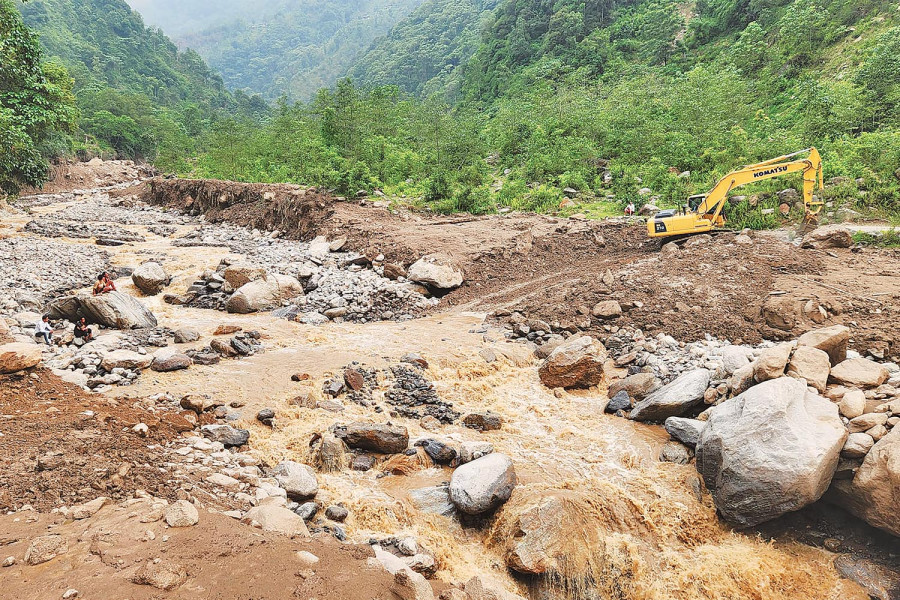National
Rains unleash floods and landslides in east Nepal
Three houses and farmlands were damaged in Khandbari of Sankhuwasabha district. Lightning kills a woman.
Post Report
At least three houses have been damaged and large areas of farmland inundated in Sankhuwasabha district by landslides and floods triggered by torrential rainfall. This is the first report of damage by landslides and floods after the first monsoon entered eastern Nepal on Monday.
“Three houses have been damaged by the landslides in ward 4 of our municipality on Wednesday night,” Mahesh Thapaliya, mayor of the Khandbari Municipality of the district, told the Post over the phone from Sankhuwasabha. “A vast swathe of fields and roads have been damaged by floodwaters.”
The flood and landslides also wreaked havoc in wards 5, 6, and 11 of the municipality. The local administration has been collecting details of the loss and damage caused by the disaster, officials at the municipality said.
According to Thapaliya, floodwaters have swept away a motorable bridge constructed over the Bhalukhola River, and floods in local streams have also caused huge damage in nearby fields.
“We have been witnessing heavy rainfall every night since Monday,” said Dinesh Kattel, an information officer at the municipality. “A woman in her mid-30s died from lightning on Wednesday.”
Authorities in another eastern district of Taplejung have also reported that a flash flood damaged a wooden bridge and sediments briefly blocked the Tamor River.
The Department of Hydrology and Meteorology said that the Sankhuwasabha district witnessed 217.8 mm of rainfall in the last 24 hours on Thursday and 119.7 mm of rainfall on Wednesday. Locals complained that the heavy rainfall occurred in a short span of time and triggered landslides and flooding.
Monsoon clouds entered the country from eastern Nepal on Monday, three days ahead of schedule. Since then, districts of eastern Nepal have been witnessing rainfall.
Met officials say various parts of the Koshi Province have been witnessing rainfall since Monday.
“Rainfall continued in several parts of Koshi Province today (Thursday) as well,” said Rojan Lamichhane, a meteorologist at the Meteorological Forecasting Division. “Monsoon is slowly progressing towards Madhesh and Bagmati provinces.”
It used to take two days for the monsoon clouds to arrive in the Valley after their arrival in eastern Nepal and around a week to spread throughout the country. However, it has not spread to other parts even in four days this year. Last year, it took some three weeks for rainfall to occur in western and far-western Nepal.
Rainfall occurred in Chitwan and Nawalparasi districts on Thursday afternoon, bringing big respite to the people suffering from scorching heat. Meteorologists, however, said the rainfall was caused by the local system and not monsoon.
Most districts, especially in Tarai, have been sweltering under extreme heat for the last several days, with temperatures soaring up to 45 degrees Celsius. Temperatures exceeding 33 degrees Celsius over the past several days have made life difficult in the Kathmandu Valley, with many residents complaining about the heat.
The Met Office issued a heat wave warning for western and far-western Tarai following the onset of the monsoon. Officials said that they may have to issue more such warnings in the coming days due to the slow progress of the monsoon towards the western parts of the country.
The monsoon season in Nepal generally begins on June 13 and ends on September 23. Last year, it started on June 14, one day later than the normal onset day.
The Met Office has forecast above-normal rains and above-average maximum and minimum temperatures this monsoon, which could unleash extreme weather events, such as flooding, inundation, and landslides.
The department’s climate section has forecast weather conditions for four months (June to September). It said most parts of the country are likely to experience above-average minimum and maximum temperatures and rainfall due to weakened El Nino conditions, and the development of La Nina conditions.
El Nino conditions are the climatic patterns in which the surface water warms, unusually.
Conversely, the cooling of the ocean surface happens in the La Nina conditions.
Being one of the world’s most vulnerable countries to the climate crisis, Nepal has witnessed multiple extreme weather events for over a decade.
Evidence suggests the maximum temperature in Nepal is rising faster, at 0.056 degrees Celsius a year, compared to the global average of a rise of 0.03 degrees Celsius a year.
Experts say extreme weather events—excessive rainfall in a short time, continuous rain for several days post-monsoon, dry spells and droughts, below-average precipitation, and above-normal temperatures in winter—have become more frequent in Nepal.




 20.12°C Kathmandu
20.12°C Kathmandu














